 |
| Category: ARMY Today |

|
|
|
|
Military Cadets in
Australia & New Zealand |
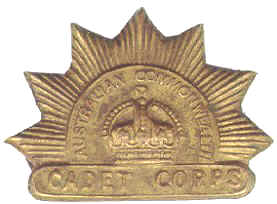 |
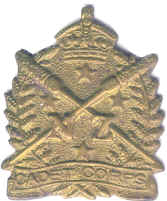
|
The original Rising Sun hat badge of the Australian Commonwealth Cadet
Corps circa 1911
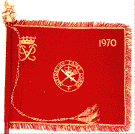
Australian
Cadet Corps Banner
|
NZ Cadet history The
numerous Cadet Corps formed during the Volunteer period became Public
School Cadets under the control of the Education Dept on July 5,
1902.
On 17 March 1911 a new Cadet Corps
was formed and was divided into Junior Cadets for boys from 12 to 14
years and Senior Cadets for boys aged 14 years and above. Each Senior
Cadet wore wore a fern leaf badge with the Unit's designated number in
the centre. After the Great War the Cadet Corps gradually adopted the
badges of the Regiment or district to which they were attached.
The General issue badge in use today
was first issued in 1950.
|
|
|
|
|

|
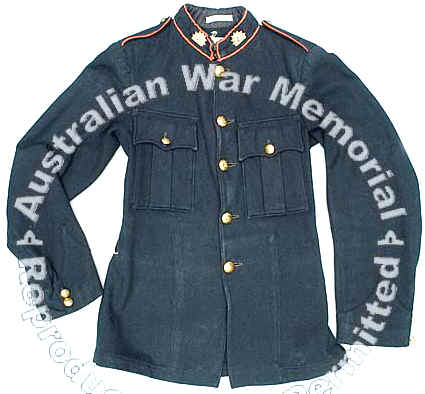 |
This
uniform was worn by Senior Cadet William Davison Walster when he
went to England with the Commonwealth Cadets as part of the
Australian 1911 Coronation Contingent.
He was aged 15 and 9 months at
the time. He was commissioned in the Commonwealth Cadet Corps with
the rank of Second Lieutenant on 28 April 1914.
Enlisted in the AIF on 31
July 1915 and served overseas with 14 Field Artillery Brigade.
Returned to Australia on 13 April 1919. |
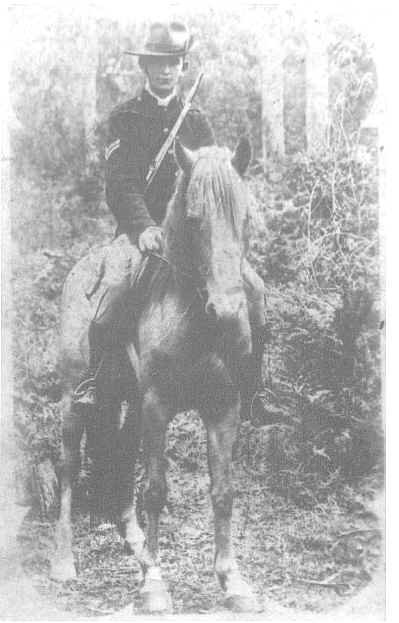 |
Alfred
Harrie Thomas (1893-1974) known in the 1911 Coronation Cadet Corps
Contingent as "Pambula Jack" after his town of origin
and his family nickname.
Because of his equestrian skill
and achievements, he was the only cadet in the unit to wear spurs.
Also shown, 2nd from right,
middle row in photo below.
Donor of both images, Ronald Thomas (son). |
|
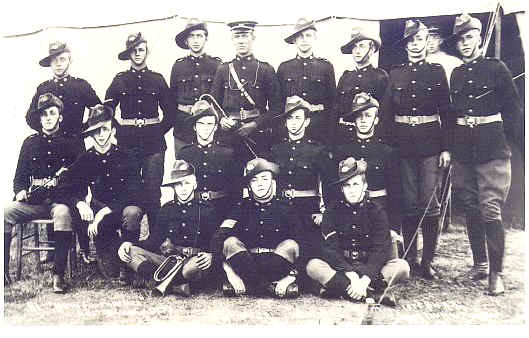
|
|
NSW Senior Cadet
1911 Coronation Contingent. |
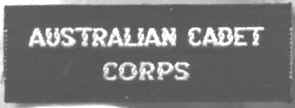 |
The shoulder flash
worn by Cadets on winter uniform |
- The history of Cadets in Australia
is rich and interesting.
- School cadets have been in
existence in Australia for over 100 years. The first unit was
established in Australia in 1866, at St Mark's Collegiate School,
NSW. This unit subsequently became the King's School Cadet Corps in
1869. Cadets remained under State auspices until 1906 when the
Commonwealth Cadet Corps was established. Conscription for part time
home service, including service by cadets, was introduced in 1909
and, under the Defence Act of 1903, the Corps was included in the
provisions for Universal Military Training.
- After 1911 it was compulsory
for all male children to take part.
- Junior Cadets were aged 12 to
14 serving 90 hours annually
- Senior Cadets were aged 14 to
18 serving 4 whole days, 12 half days and 21 night drills
annually.
- Citizen Cadets were aged 18 to
26 serving drill to the equivalent of 16 days of which 8 days
must be served in an annual camp.
- Compulsory training started in 1911
with 92 Cadet Battalions comprised of 922 Companies. Membership totaled
2,285 Officers and
86,899 Senior Cadets.
- All schools were required to join
the scheme. As at December 31, 1913 some 8044 schools were training
a total of 55,850 Junior
Cadets.
- As a result of this scheme the strength
of the Australian Army rose from 19,880 in 1904 to 48,383 in 1913.
At that stage it was anticipated that the Army would number 130,000
by 1920. As well Rifle Clubs throughout Australia numbered 1,133
with a membership of 47,500. They were encouraged by the issue of
the Government rifles with 230 rounds per member annually.
- Conscription for part-time service
was abandoned in 1929.
|
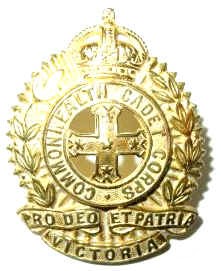
|
There is disagreement about how and
where Cadets started in Australia. New South Wales and Victoria both
claim the honour.
<<< Commonwealth
Cadet Corps (Victoria) |
|
|
Silver Commonwealth Military Competitions Medal for
Senior Cadets. On the reverse, in raised letters, are the words '.
CHAMPION . TEAM . BRIGADE COMPETITIONS'. Engraved in sloping letters is
the date '1912.13' and the words 'Sergt. J. McDonnell. 44TH BATTN'.
John Albert McDonnell was born at Illabo, NSW, in
1897, doing his pre-war compulsory cadet service with 44 Battalion in
country NSW. Married at a young age, McDonnell was working as a clerk in
Albury, NSW prior to his enlistment in the AIF in July 1915.
Posted as Private 3875 to 6 Infantry Battalion, he
sailed with the 12th Reinforcements aboard the transport A40 ('Ceramic')
in November 1915, arriving in Egypt too late to see service at
Gallipoli. 6 Battalion moved to France in early 1916, its first major
engagement being at Pozieres, on the Somme, in July. McDonnell died on
19 August of wounds received in the subsequent fighting around Mouquet
Farm, and is buried at Warloy-Baillon Communal Cemetery Extension.
|
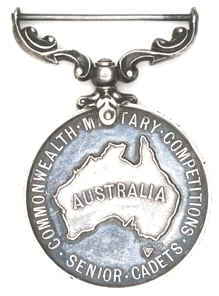
|
| Cadets
after 1929 |
- Following the suspension of Universal
Military Training in 1929, cadets were divided into two categories for
the purposes of organisation and training:
- Regimental detachments affiliated
with units of the Militia forces.
- Detachments that were generally
school-based and not affiliated with Militia units. (School-based
units did not receive Army assistance).
 |
- In 1939 Permanent Army staff were
withdrawn from the Militia and Regimental detachments were
abandoned.
- School based units continued to
function but with difficulties caused by staff and equipment
shortages.
- In 1941 cadet units began to receive
more Army support and in 1944 the provision of uniforms at public
expense was authorized. Conditions of service improved and equipment
became more plentiful. By May 1946 cadet activities were paid for by
the Army.
|
|
| Cadets
from 1949 to 1998 |

1993.
Cadet Warrant Officer Class 2 L J Harris and Cadet Under Officer L
Croake of 121 Regional Cadet Unit Wynnum. Cadet Bandsmen are in the
background. These Cadets are wearing starched jungle green uniforms,
black ankle boots and gaiters plus Sam
Browne belts. WO2 Harris later was instrumental in
starting 136 RCU Redlands and became it's first WO1 and Cadet RSM. |
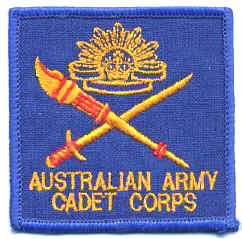
Affiliations
between Cadet units and Citizen Military Forces were developed during
the period 1949-51. At that time the title of 'Australian Cadet Corps'
(ACC) was officially adopted
(see above left).
Cadet Brigades with Regular army staff
were established and remained in operation until the mid seventies when
the Cadet Corps was disbanded by the Whitlam Government.
The Corps was reinstated in 1976 but
with a number of changes. Community based, rather than school based
units were encouraged, war-like
training was not to be conducted
and an annual camp was to be provided at no cost to the cadet.
In 1984 school based units were given the opportunity to apply for 'full
support' status and become community based units. |
|
Cadet units that
remained school-based became 'Limited Supported Units' and received very
little, if any, Army support. In 1993, the title of 'Australian Army
Cadet Corps' was approved with the short title remaining 'ACC'.
In 1998
'Limited Support Units' were accorded 'full support' status. |
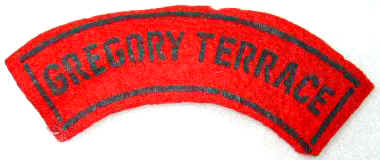 |
- Like the rest of the Army the Cadet
Units wore a cloth shoulder flash on battle Dress uniform during the
1950s and 1960s.
- Gregory Terrace High School Cadet
Unit (Qld) wore this one.
|
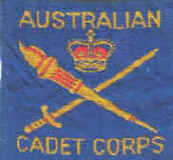 |
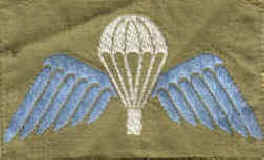 |
| Shoulder
Patch pre 1993 |
Army
parachute wings circa 1994 (Cadets) |
| Cadets
in 2003 |
 |
<< Former
Australian Cadet Forces Medal
Current Australian Cadet
Forces Medal >>
Established; December 1999
Awarded; Officers and Instructors of Cadets for 15
years efficient long service with a clasp for each additional 5
years of efficient Service.
Description; The obverse of the medal shows the
crest of the Australian Cadet Forces. On the suspension is the
St Edwards Crown. The reverse depicts the Federation Star
overlaid with an engraving bar for the recipients name. |
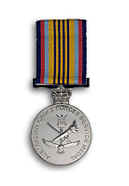 |
|
|
|
|
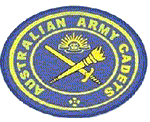
|
In 2001 the title of
Australian Army Cadets was approved with the short title of AAC.
To this day all units of the AAC are entitled to receive full support from
Army. 'Full support' entails the supply of uniforms and equipment, an
annual camp, transport to and from annual camp and training for the adult
supervisory staff (Officers and Instructors of Cadets). |
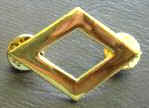
Rank badge in gilt for
Cadet Under Officer (Cadet equivalent of 2nd Lieutenant). |
|
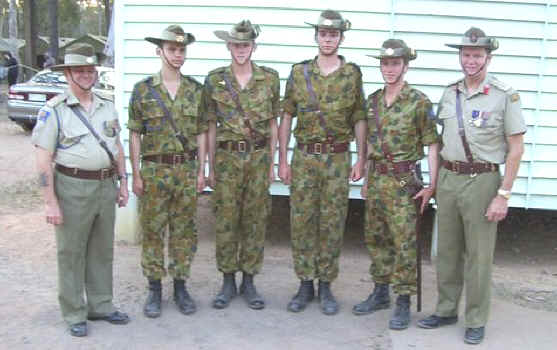
|
|
The
cadets (in the above photo) with LTCOL (AAC) Ross Brady (SCO HQ-SQLD)
and Colonel Graham Robert-Thompson MVO, RFD have been accepted
into ADFA in 2003. They
are from left - CUO Grant Joy, CUO Cameron Hawkins, CUO Clinton Anderson
and CUO Phillip James. Congratulations must also go to CPL Heston
Russell from 129 RCU at Enoggera who has been accepted to ADFA in 2003.
SGT Timothy Mills from 126 RCU Pine Rivers will be joining the Army
through general entry as a mechanic and CPL Craig Blaw, also from 126
Pine Rivers, is going to infantry. |
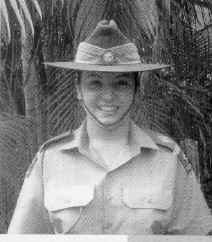 |
CUO
Lia Finocchiaro (AAC-NT) who was recently
awarded the Northern Territory University Award for Outstanding
Leadership. A
student of
Kormilda
College
in
Darwin
,
Lia was deemed to have all the attributes that are the hallmarks of
great leadership both in and out of cadets.
With
a reputation for a great energy and zest for life, Lia is a young woman
who has a burning commitment to succeed and to see a job well done.
This
year Lia was instrumental in the organisation of Year 10 and Year 12
social functions within her school along with her many duties as a Cadet
Under Officer. |
As
the highest-ranking cadet in the Northern Region, her achievements
within the Australian Army Cadets are noteworthy. They include
fundraising for widows and victims of war and the Cancer Council,
visiting local schools and assisting with their Anzac Day ceremonies,
leading a team of NCO's that was instrumental in setting up an Army
cadet unit in Alice Springs, and becoming the Public Relations Officer
for the Northern Region. As a fitting tribute to her skills and
commitment CUO Finocchiaro was named as one of the Defence Force
Volunteers of the Year for 2002 and was the only cadet to receive this
honour.
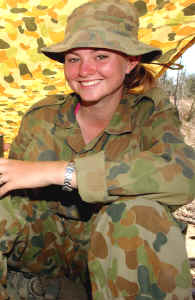 |
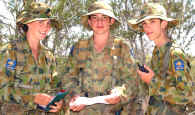
Australian Army cadets, from
left, Cadet Lance Corporal Jenna Pannigas, of Atherton, Cadet
Corporal Daniel Lee, of Malanda, and Cadet Matt Rowston, of
Atherton.
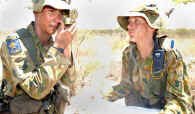
Australian
Army cadets, from left, Cadet Sergeant John Parr, 15, of 14
Regional Cadet Unit, Rockhampton, teams up with Cadet Under
Officer Samantha Hutchings, of 132 Regional Cadet Unit, also at
Rockhampton, to solve a navigation problem |
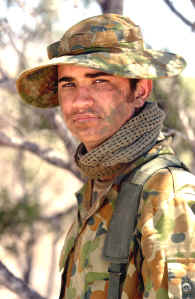
|
Australian
Army cadet, Cadet Sian McClintock, of Townsville's 130 Regional
Cadet Unit, enjoys the shade of a hutchie during the recent annual
camp for the Northern Region.
|
Australian
Army cadet, Cadet Sergeant Bernard Gilpatrick, of Mackay's 122
Regional Cadet Unit, takes time out during a navigation exercise
as part of the recent annual camp for the Northern Region.
|
|
|